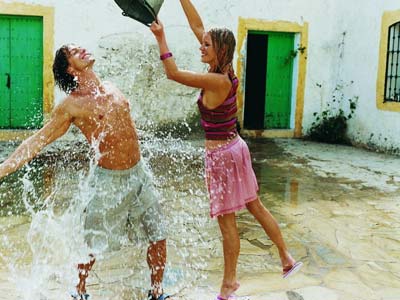Throughout history, people believed that the water has healing properties, helps to strengthen, maintain health and cope with illness. It is not surprising that such a medical procedure, a douche, appeared in ancient times. To this day, pouring water - one of the best ways to hardening of the body and treatment of many diseases.
Douche at any time, in any place: in the bath, a private bathroom, near the sea, near her house. However, in order to not hurt pouring water, and made a positive impact, it is necessary to know some of the rules for this procedure. And maybe our answers to frequently asked questions will help you learn how to pour correctly.
There are two types of perfusion: partial and general. General perfusion performed with decreasing temperature constant water temperature (from procedure to procedure and within a single procedure) from 3230 to 2520 °. Duration of the procedure from 2 to 5 minutes. Total douche for maximum effect operates up to 3 times a day (or at least in the morning and evening).
General pouring used in neuroses with symptoms of nervous system depression or hardening of the body. Partial perfusion was carried out at gradually decreasing water temperatures (3025 °) for 13 minutes on any part of the body. They are especially useful in the neuroses with poor general condition of the body, incontinence, constipation, vasomotor disorders and varicose veins of the lower extremities, as well as increased sweating feet.
Since partial perfusion, should be aware of how water affects different areas of the body. For example, a jet of water impacting on collar area, we are working on organs located in the chest. This douche is usually given with nervousness and migraine. Pouring back area are recommended for rheumatism and osteoarthritis.
Partial perfusion - is drenching the feet, lower body, back, arms and head.
What is more efficient: a drenching shower or procedure "is antiquated," with a jug and basin?
On the mechanism of its effects on the recovery of the technique in a way resembles the action soul. But according to the rules of the historically established procedures swill made from any available containers - buckets, watering cans, jugs, - which should be located at a distance of 20-25 cm from the body. Water pouring in to flock to the feet of the body, and do not spray a large flow to the sides.
This rule will not only dousing efficient use of the volume of all treated water, but also to achieve the maximum result from the procedure. Important as the sequence the effects of water on different parts of the body. First, the flow of water has to get on his back and chest, then stomach, then his arms and legs. But the head during a session of the total perfusion should remain dry.

No comments:
Post a Comment